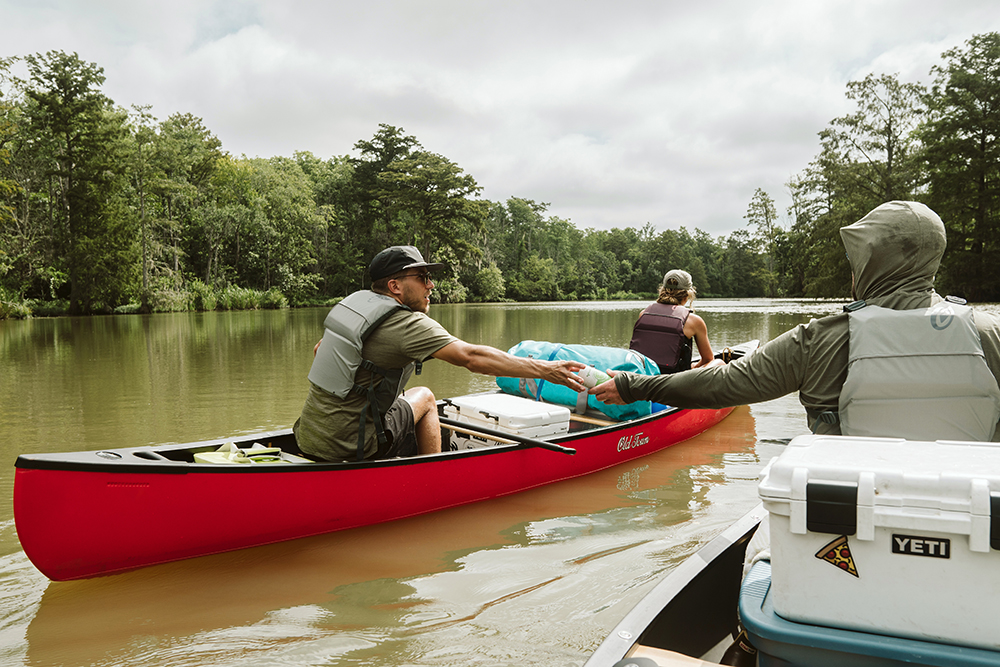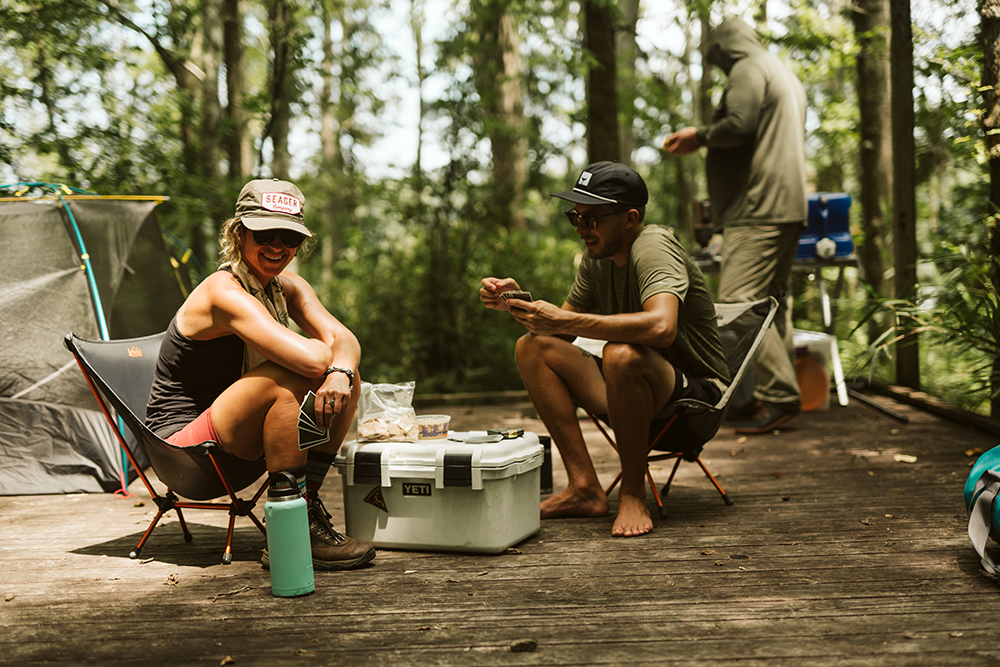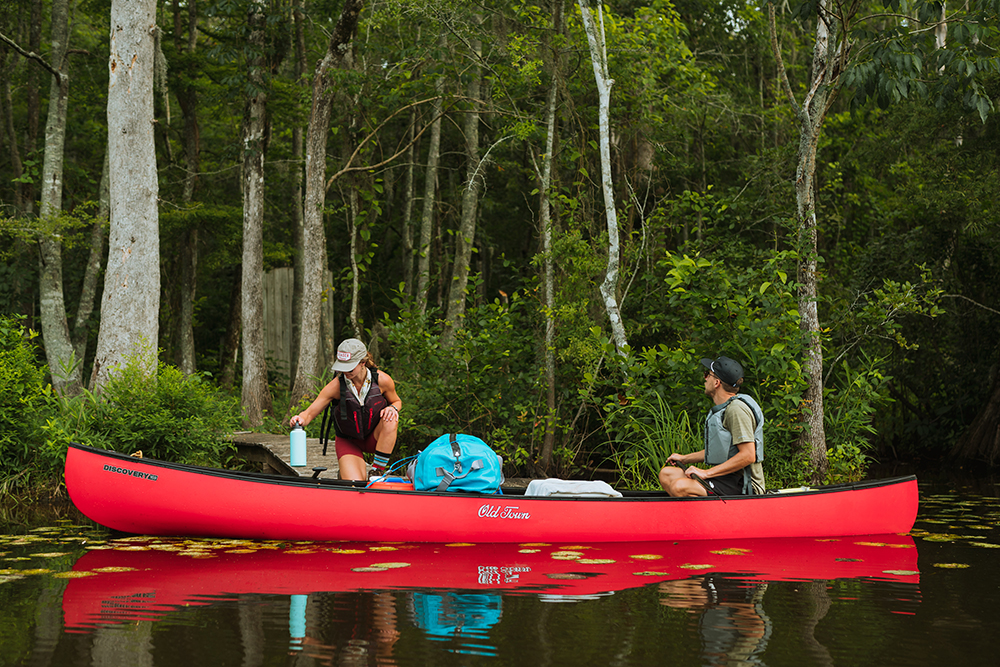Rhythm of Water: Three Days on the Roanoke
"Rivers know this: there is no hurry. We shall get there some day." - Winnie the Pooh
A bald eagle flies over our heads on its way towards the nest resting high in the hundred-year-old cypress tree on the bend of the river ahead of us. The still water reflects the cloudless sky as our canoes cut across its surface. Eagles, preferring to build their nests high above bodies of water with prominent views, often choose the towering and ancient bald cypress that grows within this watershed.

In the bright July sunshine, we push our canoes onto the Roanoke River outside Jamesville, North Carolina. Three friends and I have taken up our paddles and excitedly set out on what we hope will be the first of many river trips here in the southeast. Our experiences range from little to no paddling to class IV whitewater kayaking and rafting, to multiple week-long rafting trips covered across the west. This trip, however, is all about maximizing the time spent on the water while exploring the diverse and little-traveled backwater creeks that split off the main waterway.
The Roanoke river basin is home to hundreds of species of birds, aquatic animals, and reptiles. Locally known as North Carolina's Amazon, the Roanoke river hosts a diverse ecosystem that relies on its waters and wetlands for survival. Bears and otters loping along the banks aren't uncommon and the floodplain is home to nearly 44 species of tropical songbirds. Running 410 miles from its headwaters in the Blue Ridge Mountains, the Roanoke winds its way east across the Piedmont of southern Virginia, then into northeastern North Carolina towards the Albemarle Sound.

Historically, people & communities along the Roanoke have depended on its abundance for their food and means of commerce: lumber, fish, naval stores, and much more. The river served as a means of transportation for its earliest inhabitants and for all those who would follow. The rise and fall of its river banks offered protection and vantage points for forts during periods of war, and the volume of its water allows for the service of industry and municipalities along its banks. In 1991, the Roanoke River Wildlife Refuge was established to protect the forests in the Roanoke River floodplain, considered to be the largest intact, and least disturbed, bottomland forest ecosystem remaining in the mid-Atlantic region.
Our route has us paddling along the Roanoke for a few miles before peeling onto Broad Creek. As we leave the wide river behind the trees on either side of the creek begin to overhang our boats as the waterway narrows. Songbirds are in full chorus as the afternoon wears on. The farther we paddle back into the creek the more wildlife we disturb as herons, eagles, and even hoot owls leave their perch for new hunting grounds.
Having a background in long-distance backpacking I am very comfortable with an ultralight kit & minimal supplies while in the backcountry. River trips, however, afford the luxury of carrying gear and food that you may not typically carry in any other camping scenario. Our parties two canoes each stored a cooler and dry box as well as our personal effects. With temperatures in the low 90's it is key to have lots of cold water on hand and to be able to store fresh food for the 3 days on the water.

When researching North Carolina's rivers I quickly focused on the Roanoke for two reasons. First, its natural environment in relation to the eastern seaboard is a diverse and unique backdrop for the southeast. Secondly, a conservation group, recognizing this river's value, created and now manages 20 camping platforms along its Roanoke Paddle Trail.
The Roanoke River Keepers was established in 1996 with a mission to preserve, enhance and promote the natural, cultural and historic identity and integrity of the Roanoke River region through cultural and eco-heritage tourism and other environmentally sustainable activities. In 2021, their Roanoke Paddle Trail was designated North Carolina's 12th State Trail.
Utilizing a resource such as the River Keepers website was instrumental in the planning of this trip. They host all of the relevant information needed for creating your route and understanding the mileage between the river platforms as well as knowing river conditions and current water levels. Before heading out on any trip into the backcountry or river make sure you have a detailed plan in place that you can share with a family member or close friend detailing your entrance and exit points with expected arrival times.

On our first night, we camped on the Cypress Cathedral platform. Tucked away around a bend in the creek and behind a group of lily pads, we docked our boats and unloaded the gear onto the gangway. The group was excited to spend our first night on the water. Camp was quickly set up and dinner started on the stove. As dusk settled over the river the forest began to sing with a chorus of frogs & owls. We stayed up late that first night, telling stories and playing card games under lantern light. As we went to bed the forest kept up its song and it carried on until the morning.
We fell into the rhythm of the river on day two. The hustle and bustle of life seemed to stay on the dock yesterday afternoon while out here on the still water creek each paddle stroke pushed us farther into the reaches of the forest. Leaving camp early we were treated to overcast skies and low-hanging mist across the water. Every now and then the sun would find its way through, casting a spotlight ahead of us and flooding the Spanish moss with light. We made our way back out to the Roanoke and floated the wide river down to our next campsite. The hours melted away and once again we found ourselves tying the canoes up to the dock and setting camp amidst the thick canopy of trees. We had a grand view of the river and watched the fisherman and other boat traffic crawl across the water as dusk settled in.
River trips are a wholly unique and wonderful way to travel through and experience a landscape. Whether it's picking your way through treacherous whitewater or slowing down and exploring a narrow creek, the act of following a river and not knowing what's around the next bend is one of wonder and excitement. You feel a part of the environment when traveling on the water. The splash of your paddle and the call of the eagle as you pass underneath its home become the rhythm you expect and the backdrop against which your conversations are set.

Our final day on the water was an easy 9-mile paddle to the mouth of the Albemarle Sound, the official end of the Roanoke River. From here you would need to cross 60 miles of open water to reach the barrier islands known as the Outer Banks of North Carolina. Our speed increased as the final bridge marking the takeout came into view. Our canoes sat higher in the water with the reduced weight of our food & water supplies and despite the coastal headwind, we came into the final creek with strong spirits. As we unpacked the canoes for the final time and threw our gear into the truck, we all knew this trip was the first of many more to come.






